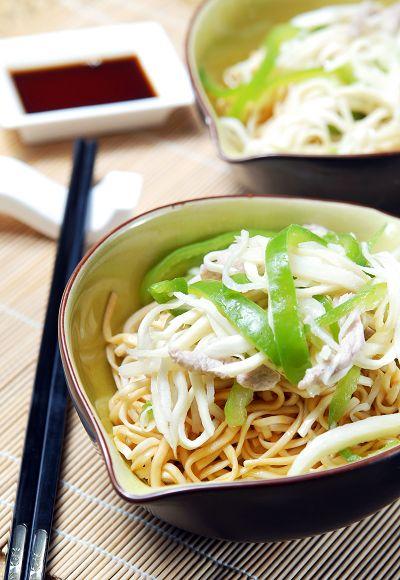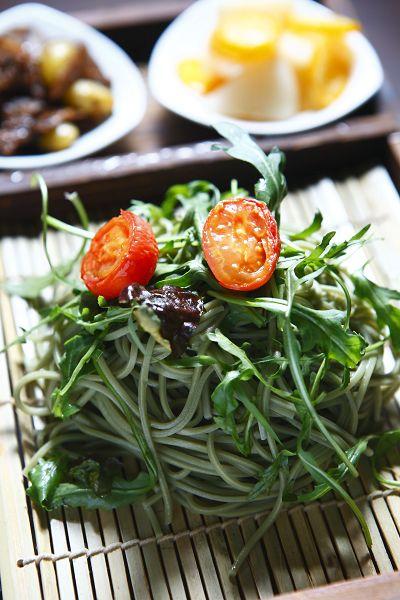 |
| Shanghai-style cold noodle.(Source: Global Times) |
by Shen Sijia
BEIJING, Sep. 14 (Xinhuanet) -- For the summer, cold noodles are not just an occasional treat, but also a great family dish. The Global Times sought out the Shanghai noodle places locals regularly line up for, as well as a number of Korean and Japanese outlets selling the best money can buy.
Shanghai surprise
There are two major chains serving popular Shanghai style cold noodles. One is the Dexing Noodle Restaurant chain with almost 20 outlets around Shanghai. Here customers can choose their own toppings; everything from the kaofu (dehydrated roasted bran, popular in Shanghai family cooking), to mengti (braised sliced pork), and xiaohuangyu (deep fried yellow fish).
The Beiwanxin Restaurant chain, with five locations in Shanghai, is another popular destination. The san si lengmian (three shredded salad noodle) is Beiwanxin's house speciality.
On the popular Shanghai-based Channel Young TV food show Renqi Meishi, resident chef Qian claims the Beiwanxin kitchen uses only authentic rice vinegar from Zhejiang Province that has been mellowed for several years, givng it a pure, aromatic but not too acidic taste.
Cold noodle restaurants use a whole host of inventive toppings to attract new customers and to keep regulars coming back. However, Beiwanxin sticks to a few traditional recipes including peanut butter, soy sauce and vinegar and chilli sauce.
Beiwanxin Restaurant
Recommended: san si lengmian
Add: 462 Huaihai Road Central, close to Chongqing Road South.
Tel: 6385 5284
Dexing Noodle Restaurant
Recommended: kaofu and mengrou toppings
Add: 529 Fujian Road Central, close to Beijing Road East.
Tel: 6360 2866
 |
| Japanese buckwheat cold noodle.(Source: Global Times) |
Fat of the land
Inside a bowl of Korean cold noodles is a whole compendium of flavors: sweet, sour, spicy, and salty - all mingling together in crushed-ice broth.
The best known Korean cold noodle restaurant in Shanghai is probably Pang Ayi (Fat Auntie), named after its owner.
Although not from Korean ethnic minority herself, "fat auntie" learnt the cooking techniques from Korea's large migr community in north-eastern China. In the noodle shop, the gaoji lengmian (premium cold noodle) at 15 yuan ($2.20) is a must. They use buckwheat noodle, spam, sliced beef, egg, pear, and cucumber as toppings.
The only complaint is that while the toppings are plentiful, the noodle portions themselves tend to be a little on the mean side. But Pang Ayi must be given credit for adapting some of its traditional northern recipes to better suit the local palate; the soup, for example, is slightly lighter and sweeter.
By comparison, the Benjia Korean Cuisine on Wuzhong Road, is at the higher end of the cold noodle market. And unlike Pang Ayi, this kitchen uses crushed ice in its soup. For the soup broth, there is a choice of chicken or spicy beef flavors.
Pang Ayi Korean Cold Noodle Shop
Recommended: premium cold noodle with delicious toppings
Add: 99 Zhapu Road, close to Tiantong Road.
Benjia Korean Cuisine
Recommended: authentic Korean cold noodles
Add: 1339 Wuzhong Road, close to Jinhui Road.
Tel: 5118 2777
Turning Japanese
During the summer, Japanese restaurants serve different types of cold noodles: from buckwheat cold noodles, to the famous Japanese udon.
For the best buckwheat cold noodles, try the mocha flavor from the Itoya Japanese Restaurant. A generous amount of dried sea-lavers are added to the soup, with a little shallot and a lightly poached egg.
Taya Restaurant on Xianxia Road may just have the best udon noodles in Shanghai. It has a wide selection from Kijoyu udon (served in a cold soup of unpasteurized soy sauce and sudachi juice, with tempura and fried tofu as an accompanying side dish), to curry udon, and the Hiyashi chukka (made with raw ramen noodles and served with lots of sliced toppings such as omelette strips, ham, chicken breasts, cucumber and bean sprouts).
The Taya Restaurant claims its udon noodle is directly imported from Sanuki Province, Japan, where the udon is thicker than normal. Sanuki Province claimed to have been the first to adopt udon after K$kai Enni, a Rinzai Zen monk, discovered the recipe on his travels to China in the 13th century.
Itoya
Recommended: mocha flavor buckwheat cold noodles
Add: 1F, 1515 Nanjing Road West, close to Tongren Road.
Tel: 5298 5777
Taya Restaurant
Recommended: tempura udon
Add: 1F, Building B, No 299 Xianxia Road, Close to Gubei Road.
Tel: 6270 0253
(Source: Global Times)





